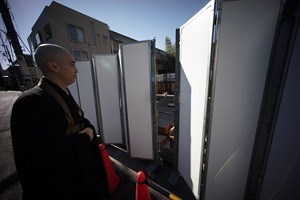
In this Jan. 8, 2015 photo, a monk Kenmyo Muta looks at the condominium construction site next to Sengakuji temple in Tokyo. The “47 ronin” samurai who inspired the long-loved saga of loyalty and honor eulogized in films, books and plays are fighting a new kind of battle in urban Japan. An apartment complex is going up next to the curved tile-roofed Sengakuji temple where the three-century-old graves of the ronin, or masterless samurai, lie. (AP Photo/Eugene Hoshiko)
January 12, 2015 - 11:42 PM
TOKYO - The "47 ronin" samurai who inspired the long-loved saga of loyalty and honour eulogized in films, books and plays are fighting a new kind of battle in urban Japan.
An apartment complex is going up next to the curved tile-roofed Sengakuji temple where the three-century-old graves of the ronin, or masterless samurai, lie. The stone monuments, standing barely waist-high, are known here and elsewhere as a humble but proud testament to sacrificing one's life for what's right.
The Buddhist monks who are still praying for the souls of the ronin, visitors from near and far, and the neighbourhood residents including those who run souvenir stores are all aghast. Nearly 2,000 people have signed a petition demanding a stop to the construction. Huge protest banners are up by the gate.
Plans show an eight-story condominium, measuring 24 metres (79 feet), dwarfing the graves and placing the temple's main wooden gate in its shadow. Building has already begun and construction is expected to be completed later this year.
"People who come and pray here, including tourists from abroad, can't believe why this is being allowed," said Kenmyo Muta, a priest at the temple. "Anyone can see what it will do to this beautiful place."
The plight of the graves highlights the recurring struggles between commercial development and the effort to preserve history.
Although many European and American cities work hard to maintain the old, Japanese cities often are a hodgepodge of cutting-edge futuristic buildings next to kitsch, if not slum-like, chaos, exemplified in sign posts galore and cheap erratic construction.
"What we are seeing here is the tragically common, ever repeating story, where a private gain is valued higher by the existing laws and planning regulations than the preservation of a public historical asset," said Christian Dimmer, assistant professor for urban design at the University of Tokyo.
Similar conflicts are unfolding around Japan, Dimmer said, especially as new earthquake-resistant technology allows for ever taller construction, setting off controversies such as whether from-the-street view of Mount Fuji might get blocked.
No illegality is involved in the condominium's construction. The neighbourhood around the temple has stayed quaint only because residents voluntarily kept buildings no higher than three stories.
There are no laws in that area to restrict the height of buildings, even if they're right next to a site designated by the government as "historic sites, places of scenic beauty and natural monuments," as were the graves since 1922.
Damaging such a site is punishable by law. But not building right next to it, said Takahiko Noguchi, a city-planning official at Tokyo's Minato ward office.
"We do see the cultural heritage site as our treasure, and we want to protect it," he said. "But we cannot force a change or a stop to the plans."
Although protesters are asking the ward to buy the property and make it part of a tribute to the 47 ronin, Noguchi said no such funding decision was likely, as money must be allocated to projects that benefit the entire ward.
The construction company Daiichi Realter Co. in Tokyo declined to comment.
Armand Piscopo, a 44-year-old salesman from New York, and first-time visitor to Japan, said he had known about "Chushingura," as the story of the 47 ronin is called, for a long time.
Overshadowing the temple with an apartment block is a "shame," he said, after inspecting the graves through the wafting smoke of burning incense.
"This should be kept exactly the way it is," said Masao Yamamoto, 64, a retired electronics engineer who came from Shizuoka in central Japan to see the graves, especially that of his favourite ronin, Horibe Yasubei, an orphaned master swordsman.
Horibe and other samurai, including 16-year-old Oishi Chikara, were ordered to commit seppuku, or ritual suicide by disembowelment, en masse. They had known that would be their end, because they had taken the law into own their hands to avenge the wrongful death of their lord.
What adds to the appeal, especially in conformist Japan, where the individual is often sacrificed for the team, is how they kept plans for revenge secret for nearly two years to avoid their plot being uncovered, and went about their daily lives, enduring taunts about cowardice.
Muta, the priest, calls it "the path to do the right thing." Even today, everyone is searching for that path, whether you are a father, schoolteacher or politician, he said.
"Three hundred years ago, they forged ahead on that path," he said.
On a snowy Dec. 14 in 1702, or so the historical legend goes, the ronin, since played by stars including Toshiro Mifune, Keanu Reeves and Kanzaburo Nakamura, donned makeshift armour and beating on drums stormed the palace of their powerful high-ranking enemy.
Later, the ronin paraded through the streets of Edo, as Tokyo used to be called, dangling the bloody head of their victim from a spear, to the cheers of onlookers who perhaps knew, even then, that the 47 ronin were destined to become eternal heroes.
Near their graves still stands the old well, where the head was washed before it was presented before the grave of their lord.
"I wonder what has happened to Japan that it can't protect its own culture," said Akane Yoshida, whose parents and grandparents run a sweet-sake shop by Sengakuji, and who leads the protests against the condo construction. "I am outraged."
___
Sengakuji online: http://www.sengakuji.or.jp/about_sengakuji_en/
Follow Yuri Kageyama on Twitter at https://twitter.com/yurikageyama
News from © The Associated Press, 2015